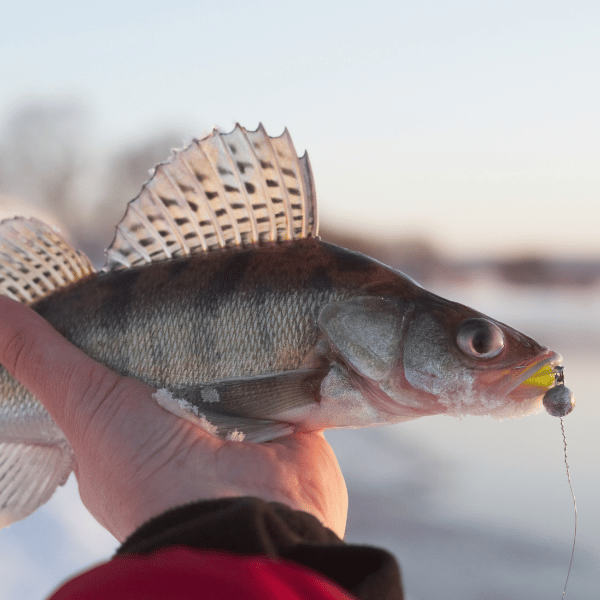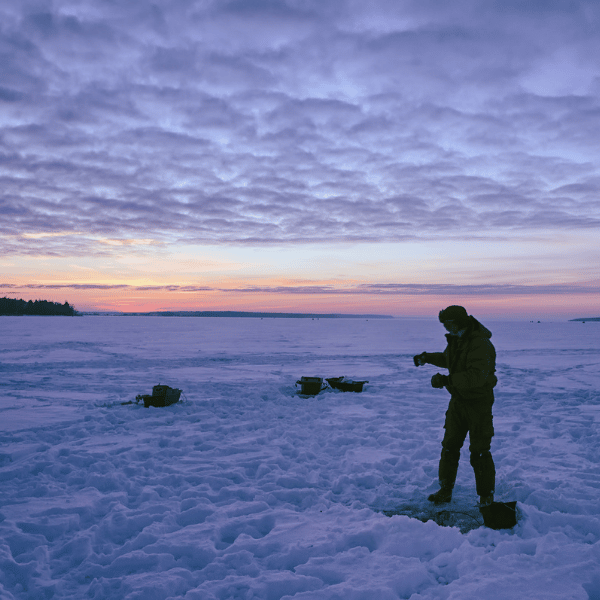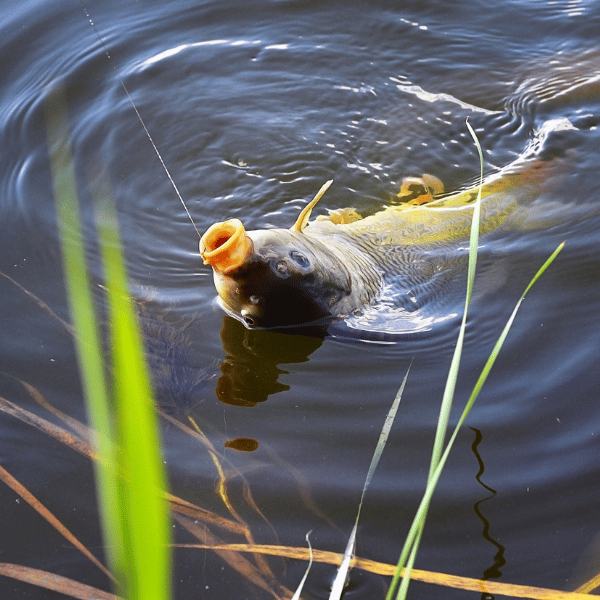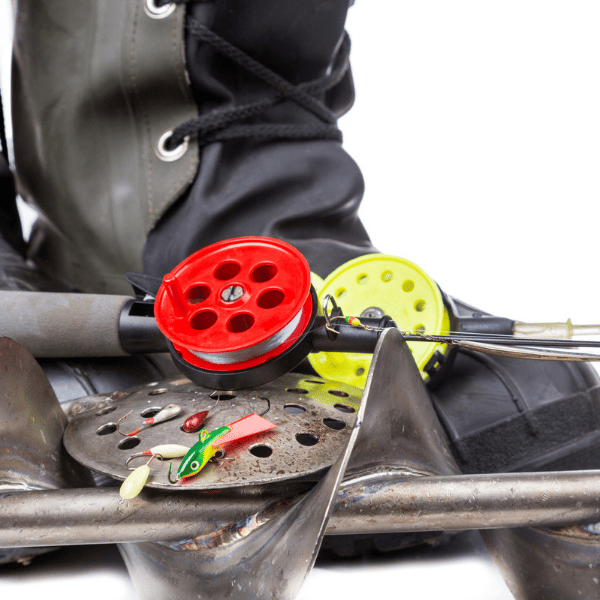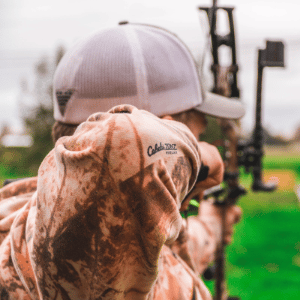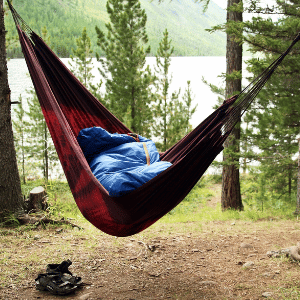
Getting started as a hammock camping beginner can be a rough start with even the most minor mistakes costing you comfort and pain.
I put together some beginner hammock camping tips to help get you over the learning curve and comfortably hammock camping in no time.
Contents
Beginner Hammock Camping

Chances are you landed on this article if you are a beginner hammock camper and you are looking for some tips for hammock camping.
When I first started hammock camping, I thought it was as easy as buying a hammock, packing some backpacking gear, and heading out. Unfortunately, I learned very quickly you need different equipment for hammock camping vs tent camping.
The goal of this article is to speed you along the learning curve to prevent you from making mistakes so you can enjoy the benefits of lightweight hammock camping.
In this article, we’ll cover:
- Essential hammock camping gear and equipment
- How to hang a hammock for camping
- Beginner hammock camping tips for success
- How to make camping in a hammock more comfortable
- Answers to the most frequently asked hammock camping questions
Let’s dive into my quick and easy step-by-step guide to field dress a deer.
Hammock Camping Gear Essentials
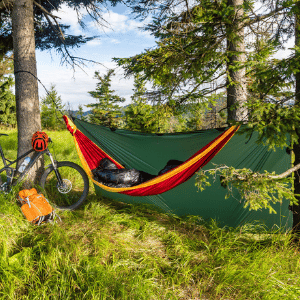
- Hammock
- Suspension system
- Hammock sleeping pad
- Sleeping bag
- Hammock topquilt
- Hammock underquilt
- Hammock rain fly
- Bug netting
The first things you’ll need are a hammock for laying and a suspension system for hanging. Hammocks should be chosen with your height, weight, and need for space in mind. Suspension systems should have wide straps to protect the trees. Ropes are a no-go on tree bark.
Next, place a sleeping pad in the hammock. Sleeping pads are either inflatable or made of foam. Inflatable pads are lightweight for backpacking and add cushioning. Foam pads also provide cushion, with the added bonus of insulation to keep you warmer at night.
Then, add a sleeping bag. Sleeping bags insulate your sides and provide some cushioning. If you have a mummy sleeping bag it protects your head as well. In warm weather, you can forgo the sleeping bag and just use a sleeping pad and top cover.
If you’re camping in cold weather, you will need another layer over your sleeping bag. We recommend investing in a top-quilt (basically an insulated blanket). You can also use a well-insulated rectangular sleeping bag. Zip it to your knees and pull the rest over you like a blanket!
In the coldest weather, an under-quilt is a necessity. Under quilts attach to your hammock suspension system and hug the bottom of your hammock. They provide the most warmth for your underside because the insulation isn’t compressed by body weight.
A rainfly covers your hammock and protects you from wind, rain, snow, sun, and peeping eyes. This all-but-essential piece of gear has its own suspension system and guy lines. Simply hang the fly above your hammock, then stake out the guy lines for maximum coverage.
Many hammock campers swear by bug netting. It eliminates the need for harmful insecticides and protects from other creepy crawlies like spiders, gnats, and flies. Bug netting typically attaches to your hammock straps.
How to Hang a Camping Hammock
Step 1: Tree Selection
Choose two healthy trees with diameters of at least 16 inches, between 12 and 20 feet apart. Now, look up. If there are any dead branches do not hang your hammock! The branches could fall during the night and injure or kill you. Hammock campers call these widowmakers.
Step 2: Hang the Suspension System
Once you’ve found a safe location with two healthy trees, attach the suspension straps around eye level.
You’ll want the foot side of your hammock around 8 inches (roughly the size of your hand) higher than the head side. So, move one suspension strap up the tree. You can adjust for comfort later.
Step 3: Attach the Hammock
It’s time to attach your hammock to the suspension system. Go ahead and clip it in.
Step 4: Adjust the Hammock Straps
The next step is adjusting your suspension straps. Experts recommend you hoist your hammock to a 30-degree angle for the most comfortable sag. Our 2-step method for checking the angle works every time.
- Channel your inner child and make a gun shape with your hand.
- Place the pointer finger where the suspension line touches your hammock and keep your thumb up. The top of your thumb should be touching the suspension strap above it
If the line is over an inch above your thumb, loosen the straps a bit. If the line is well below the top of your thumb, tighten the straps.
Step 5: Verify the Hammock Height
Now, check the height of the hammock. Any more than 3 feet off the ground and you could get injured in an unexpected fall. To check the height, take a seat. If your feet comfortably touch the ground, your hammock is ready for relaxation! If not, loosen the straps and move them up or down the tree, accordingly.
Hammock Camping Tips for Success
To help you make the most out of your overnight excursion, we’ve put together a list of 10 tips for success.
Tip #1: Research your camp location before you go. If you’re staying at a campground, call to ensure you reserve a spot appropriate for hammocks. If you’re backpacking, do some research to confirm there are places to hang your hammock.
Tip #2: When choosing a suspension system, look for polyester or polypropylene materials. Nylon will stretch throughout the night and your hammock will sag lower than the recommended 30 degrees. If you don’t wake up uncomfortable during the night, you’ll feel it in the morning.
Tip #3: Do not store food in your hammock. Not only can it stink up your sleeping berth, but it can also lead wild animals right up to your sleeping body. Just ask the guy who woke to find a mountain lion staring him in the face! He never stored food in his hammock again.
Tip #4: Layering multiple hammocks in the same tree looks cool, but it’s dangerous. It increases the risk of falls and falls from higher places. If the top hammock falls, everyone underneath could be injured.
Tip #5: If you need extra protection from the wind or rain, set up camp in a clump of trees, behind a boulder, or under the cover of another natural windbreaker.
Tip #6: Hammock camping in the rain? Tie a drip line on the hammock suspension. This will prevent water from trickling down the suspension lines and into your hammock.
Tip #7: When weight matters, bring extra clothing to layer in case the temperature falls lower than expected. If you’re car camping, keep extra layers of bedding in the car.
Tip #8: Although it makes for a cool picture, hanging your hammock over water is never good! This also applies to hanging your hammock over jagged rocks, boulders, inclines, and root clusters. All of these hazards make a potential fall more dangerous.
Tip #9: Don’t think you won’t fall at some point. It still happens to the best hammock campers from time to time.
Tip #10: If it’s cold outside, put your clothes in your sleeping bag. This serves two purposes. First, it helps insulate your body by filling dead air. Second, it’s much more tolerable to change out of your pj’s if your clothes are warm in the morning!
Make a Camping Hammock More Comfortable
Getting a good night’s sleep in your hammock isn’t intuitive. Even how to lay in your hammock isn’t readily apparent. If this is your situation, don’t worry. We’ve got you covered.
There are 4 easy steps to get comfortable in your hammock:
- Lay down in the middle of your hammock. Do this by sitting down with your bottom as close to the center as possible. Hold the side of the hammock behind you with one hand and the hammock in front of your legs with the other. Carefully move to lay down, using your grip for balance.
- Slide your legs 10 to 15 degrees (8 to 12 inches) to the right or left of center. Your hammock will flatten out a bit, and your upper body will naturally move to the opposite side.
- Continue to move your upper body until your head is the same distance as your feet, on the opposite side of the hammock. Now you should be laying diagonally across your hammock, nearly flat.
- To adjust, slide up and down the length of your hammock. Rest in a spot where you feel held. There should be no pressure on any one part of your body.
Some hammockers will experience hyper-extension in their knees regardless of sleep position. For relief, put a small pillow or clothing-filled stuff sack under your knees.
Even with the gear essentials, you might want a small pillow for your head. You can either purchase an inflatable pillow, bring a small pillow from home, or fill a stuff sack with clothing.
Hammock Camping for Beginners FAQ
Hammock camping is just as safe as tent camping. Sleeping outdoors naturally comes with some hazards, but they’re easy to avoid. Research the location, use insect protection, don’t store food in the hammock, check the weather, and pack accordingly.
This is a matter of personal preference. Some benefits of hammock camping include lightweight materials, freedom to camp wherever there are trees, wicked views, easy setup for naps, and year-round use.
A hammock should be no more than 3 feet off the ground for safety reasons. To check the height, hang your hammock and take a seat. If feet comfortably touch the ground, the hammock is at the perfect height.
No, you do not need a sleeping bag. Some hammock campers only use a sleeping pad and top quilt. It comes down to personal preference and outdoor temperature.
